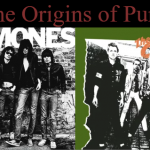1977 is generally considered to be the year punk rock broke through into the public consciousness. However, like any other musical genre, it did not appear one day fully formed. For example, a definitive punk rock moment was The Kingsmen’s “Louie Louie,” which was recorded in 1963. The 1960s garage rock movement gave rise to the proto-punk artists of the late ’60s and early ’70s, including bands like the Velvet Underground, MC5, and Stooges, who were important precursors in the development of punk rock. Right now, we’re going to chronologically consider a small sampling of 15 albums that definitively shaped punk rock. (Editor’s note – This article is a reworking of an article that I previously published on another site, and I am in the process of transferring many articles. Not all of them will be explicitly about protest music, but most will have at least some elements of it.)
Raw Power – The Stooges (1973)
This was The Stooges’ third album. As with their first two albums—1969’s The Stooges and 1970’s Fun House—it was important in the development of punk rock. It also helped establish Iggy Pop as the godfather of punk. Raw Power possesses a certain rawness and ferocity which was imitated by numerous punk artists that followed. Steve Jones of The Sex Pistols claims to have learned guitar by taking speed and repeatedly playing along to the record.
Henry Rollins of Black Flag (and Rollins Band, spoken word, and many books) has a massive “Search and Destroy” back tattoo (one of the songs on the album). Kurt Cobain also referred to the album numerous times in his journal, calling it his favorite album of all time. Raw Power was also the beginning of the Iggy Pop and David Bowie collaboration, with Bowie mixing the album.
Horses – Patti Smith (1975)
Patti Smith’s debut album helped establish the New York punk scene because she was a regular at Manhattan’s legendary punk and new wave venue CBGB. Horses also established Smith as the “godmother of punk” and the “poetess of punk.” Her radical reworking of Them’s “Gloria” contained clear elements of punk—aside from maybe the 6-minute length—while songs such as “Birdland” contained more of a jazz influence. The eclectic and experimental nature of the album was a huge influence on art punk.
Ramones – Ramones (1976)
It was hard deciding which Ramones album to include, because their first four albums are all essential punk rock: Ramones (1976), Leave Home (1977), Rocket to Russia (1977), and Road to Ruin (1978). But what better place to start than the beginning? Even though protopunk paved the way, The Ramones’ self-titled debut in 1976 is where punk was born. The album was ’50s and early-60s-style rock ‘n’ roll, but faster and louder. On the surface, that may not sound revolutionary, but no one else was doing it because they were doing disco and prog rock. The Ramones were high-energy fun with a dark, adolescent sense of humor. Between their simple musical genius and willingness to write songs about sniffing glue, the band inspired literally every punk and alternative act.
(I’m) Stranded – The Saints (1977)
The Saints were among the pioneering punk bands in Australia, making history as the first group outside the United States to release a single, 1976’s “(I’m) Stranded.” They then dropped a full album of the same name in 1977, which changed the punk landscape forever. Each track on the album exudes confidence, urgency, and authenticity as the band delivers a mix of electrifying rock anthems and emotionally charged blues-infused ballads.
Fun Fact: Their 1978 tune “Know Your Product” made Kurt Cobain’s top 50 list.
Damned Damned Damned – The Damned (1977)
The Damned’s debut album, it had the distinction of being the first full length album released by a British punk group. They were also the first U.K. punk band to release a single (“New Rose”), which appeared on the album, and for which they shot a promo video. The album possesses loads of energy, a sense of humour, and edgy satire. Also, as a nod to their proto-punk forefathers, Damned Damned Damned features a cover of The Stooges’ “I Feel Alright” (aka “1970” from Fun House).
Young Loud & Snotty – Dead Boys (1977)
Originally from Cleveland, the Dead Boys moved to New York City in 1976 at the urging of Joey Ramone and became regulars at the now-legendary punk scene emerging at CBGB. The band released their debut, Young Loud and Snotty, a year later. The album opens with the classic “Sonic Reducer,” and it does not let up. At a time that was dominated by disco, and rock was becoming bloated, the Dead Boys’ straight-ahead approach was refreshing. Along with other punk bands of the time, they helped bring fun, rebellion, and short songs back to the world of rock.
Never Mind the Bollocks, Here’s the Sex Pistols – Sex Pistols (1977)
Even though Never Mind The Bollocks is the only studio album that the Sex Pistols released, it was enough to establish a lasting legacy. Another from the Class of ’77, Bollocks has become not just one of the most influential punk albums, but one of the most influential albums in the history of rock. Even though the Sex Pistols’ music and image are not particularly shocking by today’s standards, it was certainly controversial back in 1977. Never Mind The Bollocks was a rebellious kick in the ass that rock music needed.
Blank Generation – Richard Hell & The Voidoids (1977)
Following his time with Television and The Heartbreakers, both of whom are known for their impactful early punk albums, Richard Hell created a backing band named the Voidoids and released one of the defining albums of the era. The title track has become an iconic punk anthem, while the album itself offers a comprehensive look at what made the New York CBGB’s music scene of the 1970s so thrilling.
Marquee Moon – Television. (1977)
The groundbreaking debut album by Television is a seminal work in the development of art punk. The title track, “Marquee Moon,” is a 10-minute epic that combines jagged riffs with a mesmerizing melody, highlighting the band’s avant-garde approach. Songs like “See No Evil” and “Friction” exemplify their unique blend of punk energy and art rock sensibilities. The album’s innovative sound and introspective lyrics have influenced countless musicians, solidifying its place as a classic in rock history.
Pink Flag – Wire (1977)
You could make a persuasive argument to include any of Wire’s first three albums: Pink Flag (1977), Chairs Missing (1978), or 154 (1979). The latter two albums are a bit more experimental and influential in the development of art punk and post-punk. Pink Flag is by far Wire’s most straight-out punk album. With 21 songs in just over 35 minutes, Pink Flag is a minimalistic masterpiece. The album is raw and raucous, and still sounds fresh.
Germfree Adolescents – X-Ray Spex (1978)
This debut album by the UK punk band tackles consumerism, feminism, and identity politics. Poly Styrene, the lead singer and primary songwriter of X-Ray Spex, significantly influenced many feminist punk acts and genres, including the ’90s riot grrrl movement. Some later reissues of the band’s album feature additional tracks, including their 1977 classic empowerment single, “Oh Bondage Up Yours!“
(GI) – Germs (1979)
Not only is it the full-length album released by the Los Angeles band, it is also considered one of the first hardcore punk albums. It was also important in the development of West Coast punk, as chronicled in Penelope Spheeris’ 1981 documentary, The Decline of Western Civilization. Produced by Joan Jett, who had recently left The Runaways, (GI) has a definite rawness and edge. Unfortunately, the band broke up shortly afterward, which was followed shortly thereafter by the tragic suicide of front man Darby Crash. Lead guitarist Pat Smear went on to greater fame during his brief stint as second guitarist of Nirvana and later in the Foo Fighters.
Cut – The Slits (1979)
The debut album from the mostly female UK punk band tackles a variety of topics, including traditional gender roles, consumerism, media propaganda, and the dangers of drug abuse. The adventurous albums include elements of dub, and they powerfully harness the raw and empowering spirit of punk that transcends any technical limitations. Tunes such as “Typical Girl” were pivotal in the development of feminist punk movements such as riot grrrl.
Inflammable Material – Stiff Little Fingers (1979)
Inflammable Material is the debut album from Stiff Little Fingers. Hailing from Belfast, Northern Ireland, the songs focus on the political turmoil that was ever-present in Northern Ireland of the 1970s. In many ways, Stiff Little Fingers were Ireland’s answer to The Clash. Instead of sharing the anarchistic and nihilistic stance of punk acts like the Sex Pistols and Germs, their music dealt more with the possibility of positive change. The music on Inflammable Material is aggressive but positive at the same time. It successfully balances righteous indignation with a sense of hope.
London Calling—The Clash (1979)
Released at the very end of 1979, London Calling was The Clash‘s third album, and it showed the band well beyond the confines of traditional punk. It incorporated elements of reggae, ska, funk, soul, jazz, and rockabilly. Even though they flirted with these genres on their first two albums—1977’s self-titled and 1978’s Give ‘Em Enough Rope—these musical styles were a lot more pronounced on London Calling. Punk purists may prefer the first two albums, but for things not to become stagnant, they need to evolve. London Calling was important not only for the evolution of The Clash, but the evolution of punk rock. As with previous Clash albums, the lyrics have an elevated level of social consciousness. Very few songwriters could articulate the plight of the common man the way Joe Strummer could.
Fun fact: The iconic album cover was honored in the U.K. when the Royal Mail featured the album cover on a postage stamp.


